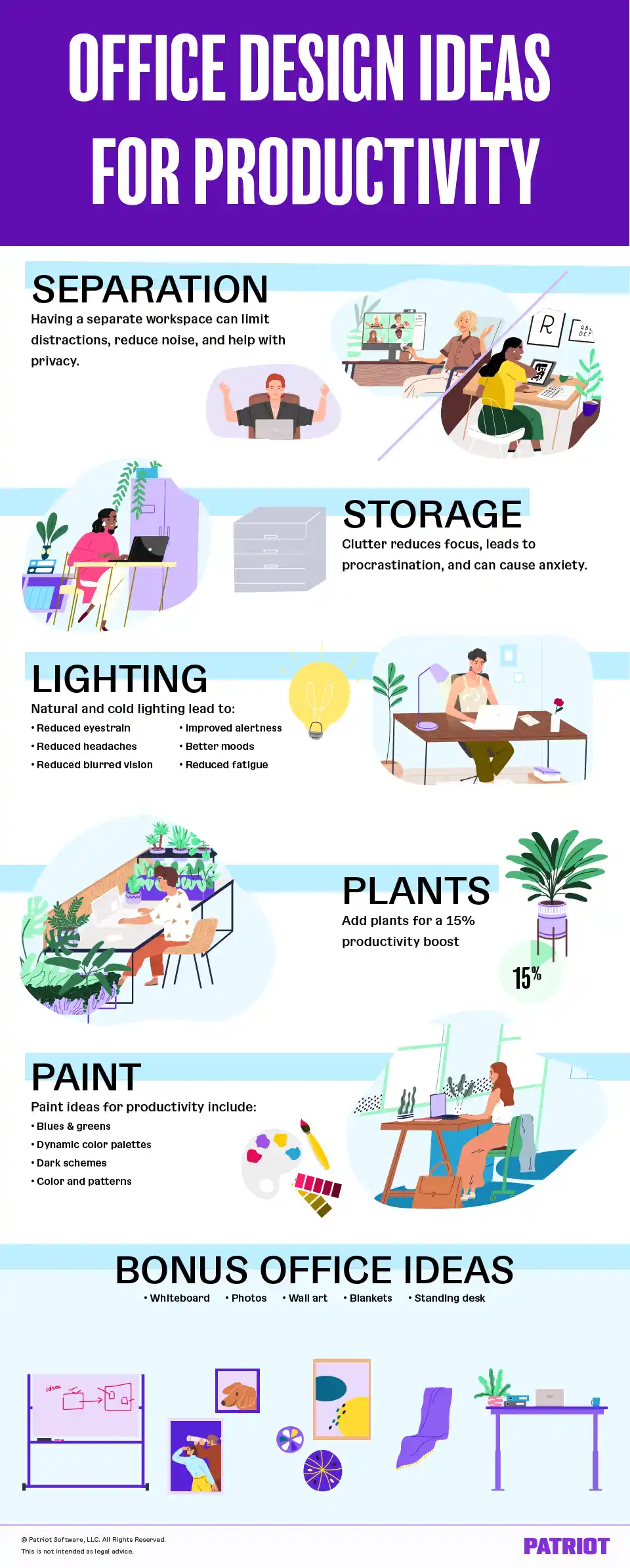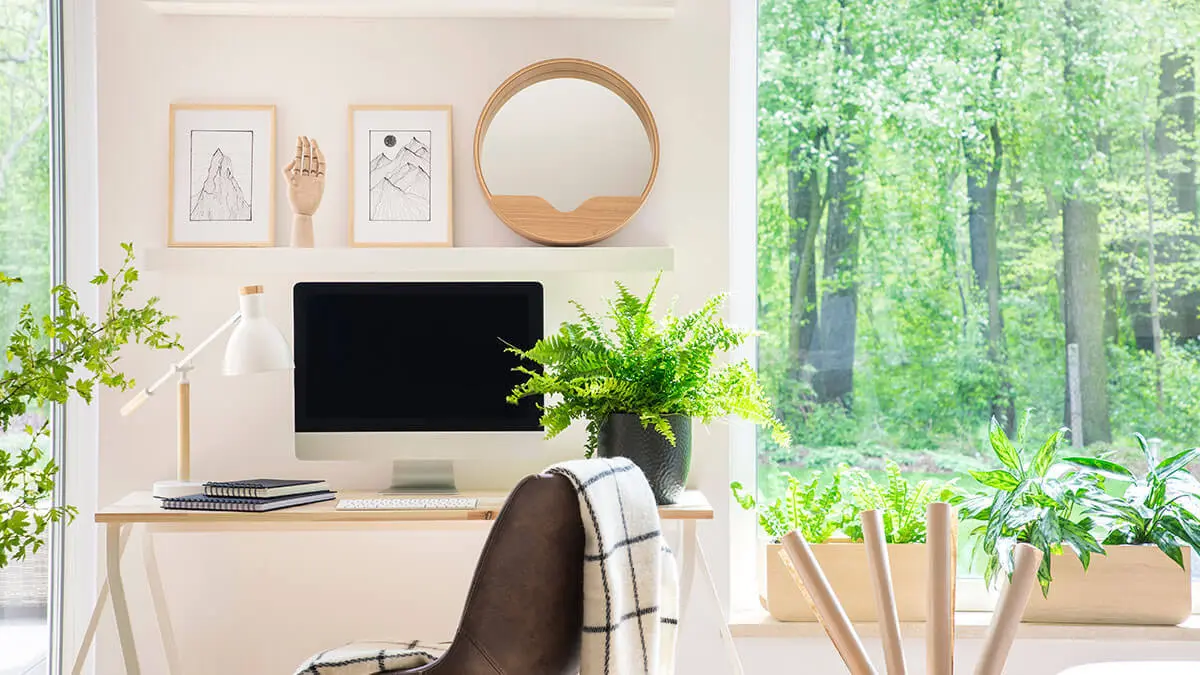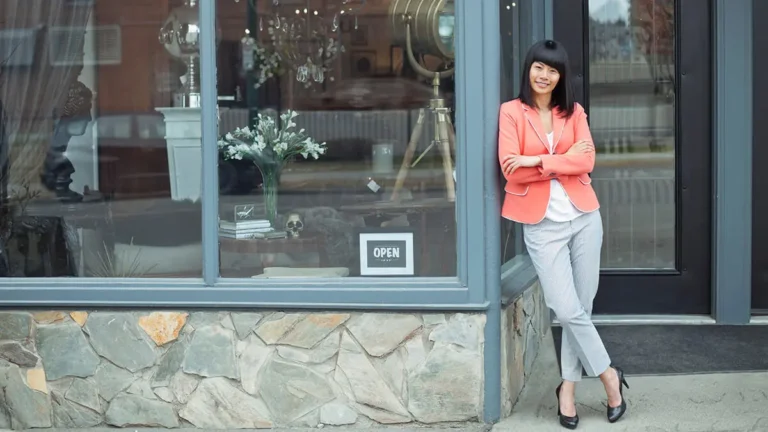The key to productivity is engagement, consistency, focus, organization, and … design? Actually, yes. An employee’s happiness goes hand in hand with productivity. And as we all know, it’s the little things in life.
Just consider these survey stats from Formstack:
- 81% of HR decision-makers believe pets in the workplace increase productivity
- 53% of employees are less productive when their work environment is too cold
So yes, everything from pets to temperature contributes to productivity—including office design. Without further ado, read on for some office design ideas for work to try out in your home or office.
6 Office design ideas (and tips)
Whether you’re putting together an entire office for you and your employees or just a personal space, here are six ideas to get going.

1. Separation
Do you work in the office? At home? No matter where you work, separation comes in handy to help cancel out noise, limit distractions, and foster productivity.
Picture these scenarios:
- At home: It’s been a long and productive day at work, but you’re (finally!) getting to a good stopping point—in about an hour. But when your kids come running into your living room-turned-office, you find it hard to get back into the groove.
- In the office: Employees on either side of you are on the phone with customers. You’re writing an email to an investor and bam! You accidentally typed what someone next to you was saying. Whoops—if only you could go back and retrieve that email…
You can’t escape distractions and noise. But by creating a separate workspace, you can create the best office layout for productivity by limiting them.
How to create separation if you work from home
Set up a separate home office away from your living and sleeping areas. If you don’t have enough rooms to do so, work with what you have. You might consider turning a loft into an office or using dividers to create a separate workspace.
Kristen Bolig, CEO of SecurityNerd, offers advice on what to do if you work out of your bedroom:
If your WFH office is in your bedroom, it’s incredibly important to create a strong separation between work and sleep so that you remain productive and can sleep well at night. Two things that can help with this are always making your bed and getting an ergonomic desk chair. It is more difficult (and less tempting) to get into a made-up bed, and having an ergonomic chair will make sitting at your desk more comfortable, minimizing the desire to lay down as often.”
How to create separation if you work in the office
More than likely, you and your employees need some privacy from time to time to make calls, get in the zone, or collaborate with a small group of co-workers. Consider an office design that has a mix of closed offices and cubicles to give employees privacy when they need it.
From decorations to marketing strategies, our small business blog covers it all.
Get the latest small business news delivered straight to your inbox.
Subscribe to Email List2. Office organizers/storage
Quick: Look at your desk right now. Not after cleaning it. What’s on it? Wrappers, empty coffee mugs, Post-it notes, headphones (because who doesn’t love a little music in the workplace?), books, and/or files? If you have at least one of these on your desk, welcome to the clutter club.
Nobody likes clutter. In fact, clutter is one of the most well-known productivity killers out there. And according to the Harvard Business Review, here are some reasons why:
- Focus: Disorganization drains our cognitive resources and reduces our ability to focus.
- Procrastination: Individuals overwhelmed by home clutter are more likely to procrastinate.
- Mental health: Clutter can lead to stress, anxiety, and depression.
Consider designing your office with organizers/storage in mind. Use desks with drawers, get filing cabinets, or take advantage of sleek bookshelves to help tuck the clutter away.
If you’re overcrowded and short on space, consider maximizing the space you do have by going up. Utilize vertical space with shelves, rods with hooks, and stackable organizers.
3. Lighting
Lights, camera, action! Sure, you need lights to see. But there’s a reason lights come first in the famous cliché. You don’t just need the best lighting for theatrical performance—you also need the best lighting to give your best performance.
Not sure how lighting and productivity tie together? Take a look at a few lighting-related facts:
- Natural lighting reduced workers’ eyestrain, headaches, and blurred vision symptoms by 84% in one study.
- Cold lighting (i.e., blue-white) is used in brainstorming rooms to improve alertness, mood, and productivity, and reduce fatigue.
Natural light to ease discomfort? Productivity boost. Cold lighting to improve alertness and reduce fatigue? Double productivity boost.
If you want to design your office to maximize productivity, consider choosing a room or space with plenty of windows for natural light. Can’t make that happen? Skip the yellowish lights and opt for cooler colors, like white and blue-white tones.
4. Plants
Quick—grab a plant and stick it on or near your desk. Why? You could get a productivity boost of 15% with this simple trick, according to research.
If you aren’t sure what plants have to deal with productivity, you’re not alone. But there are numerous benefits of adding plants to your office design, such as:
- Increased concentration
- Improved air quality
- Reduced stress
- Boosted tranquility
And when it comes to productivity, some plants simply work better than others. Consider low maintenance, hardy plants like bonsai, snake plants, and spider plants.
Hazard! Dead plants have the opposite productivity and tranquility effect. Make sure to take care of your office plants according to their care instructions (e.g., natural light, water, etc.).
5. Paint
Look at the walls in your office area. What color are they? If you’re staring at white or off-white walls all day long, your productivity levels could chip away.
Why? White and gray walls are, well, kind of sterile and boring. In fact, researchers say you should never paint office walls white if you want to be more productive.
So what kind of paint should you go with? The consensus tends to point in the direction of blues and greens for ultimate focus. But hey, everyone’s different.
If blues and greens don’t appeal to you, Home & Gardens has some other ideas for inspiring home office spaces (which you could likewise apply in the office), including:
- Dynamic color palettes
- Dark schemes
- Color and patterns
6. Bonus: You do you
Office design ideas are all well and good, but the bottom line is that you need to make your space your own. What are the unique office decor ideas for work that will help you specifically?
Amy Kite, Owner of The Kite Team, found that adding a whiteboard to her home office was a great way to immediately see a boost in productivity. Kite shares:
Writing things down in print helps keep me on task and with my eye on the prize. I have a whiteboard in my home office, which has paid for itself 10x over because of how much more productive it makes me. I recommend whiteboards for any and all office designs!”
Other examples of office decor to stay productive throughout the day include:
- Blankets
- Desk lamps
- Standing desks
- Paintings
- Beanbag chair
- Wall art or photos
At the end of the day, you need to do you. So, what professional office decor ideas could help you stay focused and distraction-free?
This is not intended as legal advice; for more information, please click here.



